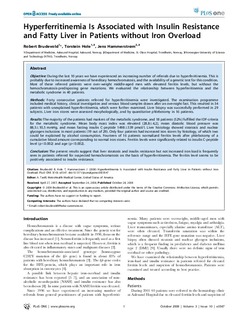| dc.contributor.author | Brudevold, Robert | |
| dc.contributor.author | Hole, Torstein | |
| dc.contributor.author | Hammerstrøm, Jens | |
| dc.date.accessioned | 2015-10-29T13:16:51Z | |
| dc.date.accessioned | 2015-12-10T15:37:49Z | |
| dc.date.available | 2015-10-29T13:16:51Z | |
| dc.date.available | 2015-12-10T15:37:49Z | |
| dc.date.issued | 2008 | |
| dc.identifier.citation | PLoS ONE 2008, 3(10):e3547 | nb_NO |
| dc.identifier.issn | 1932-6203 | |
| dc.identifier.uri | http://hdl.handle.net/11250/2367524 | |
| dc.description.abstract | Objective:
During the last 10 years we have experienced an increasing number of referrals due to hyperferritinemia. This is probably due to increased awareness of hereditary hemochromatosis, and the availability of a genetic test for this condition. Most of these referred patients were over-weight middle-aged men with elevated ferritin levels, but without the hemochromatosis-predisposing gene mutations. We evaluated the relationship between hyperferritinemia and the metabolic syndrome in 40 patients.
Methods:
Forty consecutive patients referred for hyperferritinemia were investigated. The examination programme included medical history, clinical investigation and venous blood samples drawn after an overnight fast. This resulted in 34 patients with unexplained hyperferritinemia, which were further examined. Liver biopsy was successfully performed in 29 subjects. Liver iron stores were assessed morphologically, and by quantitative phlebotomy in 16 patients.
Results:
The majority of the patients had markers of the metabolic syndrome, and 18 patients (52%) fulfilled the IDF-criteria for the metabolic syndrome. Mean body mass index was elevated (28,8±4,2), mean diastolic blood pressure was 88,5±10,5 mmHg, and mean fasting insulin C-peptide 1498±539 pmol/l. Liver histology showed steatosis and nuclear glycogen inclusions in most patients (19 out of 29). Only four patients had increased iron stores by histology, of which two could be explained by alcohol consumption. Fourteen of 16 patients normalized ferritin levels after phlebotomy of a cumulative blood amount corresponding to normal iron stores. Ferritin levels were significantly related to insulin C-peptide level (p<0.002) and age (p<0.002).
Conclusion:
The present results suggest that liver steatosis and insulin resistance but not increased iron load is frequently seen in patients referred for suspected hemochromatosis on the basis of hyperferritinemia. The ferritin level seems to be positively associated to insulin resistance. | nb_NO |
| dc.language.iso | eng | nb_NO |
| dc.publisher | Public Library of Science | nb_NO |
| dc.title | Hyperferritinemia is associated with insulin resistance and fatty liver in patients without iron overload | nb_NO |
| dc.type | Journal article | nb_NO |
| dc.type | Peer reviewed | en_GB |
| dc.date.updated | 2015-10-29T13:16:51Z | |
| dc.source.volume | 3 | nb_NO |
| dc.source.journal | PLoS ONE | nb_NO |
| dc.source.issue | 10 | nb_NO |
| dc.identifier.doi | 10.1371/journal.pone.0003547 | |
| dc.identifier.cristin | 361416 | |
| dc.description.localcode | © 2008 Brudevold et al. This is an open-access article distributed under the terms of the Creative Commons Attribution License, which permits unrestricted use, distribution, and reproduction in any medium, provided the original author and source are credited. | nb_NO |
